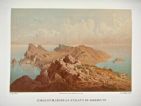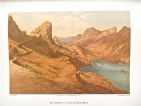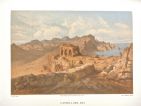
From Pollença to Es Cap de Formentor
"The path from Pollença to Sant Vicenç passes by Can d’En Camp. To the right we see a rocky hill called Es Beguins, its base carpeted in Holm oaks. We cross the stream whose left bank is lined with agaves. To our right is the path to the Llenaire “possessió” (estate). Santueri mountain, round, prominent and very regularly shaped, comes into view; it serves as the ambassador of another mount called Sa Punta. We abandon the Es Camí des Port path and take the one on the left towards the sea, also leaving behind the one leading to the Possessió de Sa Font.
 After a turret, we see an orange grove to the right and a white house called Can Botana, surrounded by Holm oaks and at the base of a conical hill covered in pine trees. Behind this hill, the tall Formentor peaks stand out. Farther down the path is San Vicenç; to the left and behind a small Holm oak forest is Can Martorell which at times bubbles with water when the wind blows hard despite the lack of rain. It is thus known as “La fuente loca” (the crazy spring). Next comes the little and old Hort de Sant Vicenç house, with a central arch and square tower. From here is a splendid view of both the sea and Sant Vicenç tower, as well as of Pollença, with the “puig” and En Marc Valley. No less pretty is the panoramic view of the prominent Formentor from the path that descends to the coast.
After a turret, we see an orange grove to the right and a white house called Can Botana, surrounded by Holm oaks and at the base of a conical hill covered in pine trees. Behind this hill, the tall Formentor peaks stand out. Farther down the path is San Vicenç; to the left and behind a small Holm oak forest is Can Martorell which at times bubbles with water when the wind blows hard despite the lack of rain. It is thus known as “La fuente loca” (the crazy spring). Next comes the little and old Hort de Sant Vicenç house, with a central arch and square tower. From here is a splendid view of both the sea and Sant Vicenç tower, as well as of Pollença, with the “puig” and En Marc Valley. No less pretty is the panoramic view of the prominent Formentor from the path that descends to the coast.
The tower dominating the double inlet is round in back and triangular in front. Its diameter is nine “varas” thick and up to eleven “varas” tall. It has an embrasure to protect the port and a window onto the sea. It also has a two-foot-thick parapet, today the home for numerous aloe plants with their intense yellow color and red streaks. From here the view of the wild sea on stormy days is impressive. Next to the Torrent de la Font Peixera many, very vigorous Holm oaks grow.
After crossing the torrent, the path from Pollença to the port moves through plantations of olive, fig and almond trees closed off by dry stone walls. To the right is a long though not very tall slope. The path continues at the base of the mountains that separate the port from Sant Vicenç valley and passes by the Sa Punta house next to which there is another building. It then curves along the slope covered in fan palms, and we begin a soft descent.
On a hill full of exuberant prickly pears, the Llenaire house rises up. It has a half-point arch entrance and a well up front. The view from here is certainly pretty, encompassing the plain, Pollença valley and Colonya planted with olive trees, the rounded Puig de Santueri and Puig de Mare de Déu.
To the left, the first sheer walls of Cap Formentor appear, and olive and carob tree groves follow the tilled fields and fig trees. To the left are two small “possessions”, Can Vela and Gotmar, followed by the round tower of a now disappeared windmill, offering splendid views of Albercutx. To the right is a pine grove with svelte trees featuring voluminous crowns. On the other side is s’Illa, with Bóquer farther off. Amongst the chain of Formentor’s mountains, the first thing that stands out is the peak which follows a valley, Bóquer, with another summit and reddish fields, then Albercutx and its valley closed off by another knoll.
Around Bóquer, almond and fig trees are abundant. The house has a tower with an embankment, a half-point arch portal and square windows. A house built long ago at the same height as the current one and later expanded serves as today’s “clastra” (cloister). Behind it are numerous picturesque crags covered entirely by mastics and fan palms.
The valley widens at the top after making room for fields growing cereals and holding fig tree groves, surrounded now by barren fields, the kingdom of esparto grass. We thus climb up slowly amongst large rock formations towards an isolated house. Little by little, we notice that the walk is increasingly harder and steep. Another small house appears, and the valley widens once more before descending in search of the sea.
 From the “moll”, the path continues along the shore then straight towards the Albercutx house on a hill in the valley of the same name and closed off by the prominent Penya del Migdia. The house is quite simple, with a half-point arch and some old hackberries guarding the entrance. From here is a picturesque image of Pollença Bay as is the view encompassing the smooth waves of mountains in the distance and Alcúdia. The bottom of the valley seems completely occupied by large plantations of fig trees and a small forest of pine trees at the foot of Penya del Migdia; the rest is uncultivated land.
From the “moll”, the path continues along the shore then straight towards the Albercutx house on a hill in the valley of the same name and closed off by the prominent Penya del Migdia. The house is quite simple, with a half-point arch and some old hackberries guarding the entrance. From here is a picturesque image of Pollença Bay as is the view encompassing the smooth waves of mountains in the distance and Alcúdia. The bottom of the valley seems completely occupied by large plantations of fig trees and a small forest of pine trees at the foot of Penya del Migdia; the rest is uncultivated land.
The path continues from the Albercutx house towards Penya del Migdia with views of Pollença Bay. When it reaches a “coll” (hillock), it begins its climb to the “talaia” (watchtower). On the slope are two cisterns with flat roofs, serving in summer to herd goats and sheep by means of Cossis. The image from here of the double inlet is particularly charming.
 The tower, built in 1629, has arrow-slits and barbicans on three sides as well as a small door towards the south, at a comfortable height and without stairs as the steps that were once held by ropes are now on the ground, and the climb is impossible. From this tower to the east is a beautiful view of Colomer Island, two crags populated by pigeons and s’Illa to the right. Also on this side are the Pinola promontory and Puig d’En Marc followed by Castell d’Albercutx castle.
The tower, built in 1629, has arrow-slits and barbicans on three sides as well as a small door towards the south, at a comfortable height and without stairs as the steps that were once held by ropes are now on the ground, and the climb is impossible. From this tower to the east is a beautiful view of Colomer Island, two crags populated by pigeons and s’Illa to the right. Also on this side are the Pinola promontory and Puig d’En Marc followed by Castell d’Albercutx castle.
 We then cross through a dense pine grove, its exuberant blanket underneath consisting of rosemary, fan palms and mastics. We reach the limestone bottom of the valley where, on a soft slope on the left and not far from a tall pine tree is the Formentor house.
We then cross through a dense pine grove, its exuberant blanket underneath consisting of rosemary, fan palms and mastics. We reach the limestone bottom of the valley where, on a soft slope on the left and not far from a tall pine tree is the Formentor house.
Formentor, with its “clastra” and old Holm oak, is a modern building, with five windows on the long sides and two on the short sides. It has a tower made of sandstone blocks with rounded windows and loopholes, with two arrow-slits more on the lower right part to guard the door.
We continue down the path and, after crossing through a forest of pine trees, we reach a “coll” which opens onto the Font de ses Egües (mare spring) and the little valley which descends to Cala Figuera cove and where, at the base of a peak called Fumat, we find the Hort de Cala Murta (dead cove garden). We turn to the right and then, through a steep ravine, we descend to Cala Murta on a path lined with fan palms and into an exuberant pine grove, perhaps one of the oldest and most dense on the entire island. Standing out amongst them are five enormous trees whose owner has proposed they never be cut down. The tallest is called Pi de la Pouada next to the shore.
We now pretend to climb the sheer Fumat mount, its peak at 334.35 m above sea level and whose slopes are dressed in fan palms with thick trunks. The view provided is similar to that from the “talaia” watchtower except in the opposite direction: the entire Formentor Valley up to the thin lighthouse tower.
 Once again, the view of the mounts overlooking Cala Figuera is singularly splendid.
Once again, the view of the mounts overlooking Cala Figuera is singularly splendid.
On the north are rocky walls, without vegetation, which fall vertically over the sea. The cape deepens down to the shore of the point, and, to the right of the lighthouse, our eyes discover a carved out rock called the Pont de les Moles bridge. A steep path forms three curves, the last stepped, to reach the nearest cove. People frequently visit the lighthouse climbing up from Cala En Gossalba. All over the Cap Formentor area, numerous, short and very thorny plants called “eriçons” grow, in addition to old maritime pines oozing resin and which supply excellent wood for construction.
The greatest attraction in Pollença, the place which has extended its reputation throughout the island is, without doubt, Puig de la Mare de Déu, also called Puig de Pollença, which rises up to some 600 m above sea level. It’s isolated and conspicuous at 5.6 km from the town.
A thick corridor with a half-point arch window communicates the building with the tower. Before there was only a drawbridge. Five steps on the right climb to the small doorway on whose lintel we can read the date, 1790. And, above the wall, a hallway leads to a door to access the building. The windows on this side all have a parapet, without exception. A wide terrace or patio under the shade of two old hackberries opens up in front of the entrance surrounded by a wall.
The “rebost”, used to store table cloths, bed linen and all cooking utensils, is found on the lower floor, just like the large kitchen for pilgrims and the clay Santa Eugènia cups used for wine. The building also serves as the residence for the “Donat” who must be married but without children. His wife has to tend to the kitchen and the pilgrims demanding her services. The southern wing of the building is destined for use as the refectory or dining hall.
The church situated to the northwest of the inn is relatively large but only consists of a single nave with a choir above the main entrance. The chairs in the choir are in a very old and coarse style. Two pointed, extremely tall arches hold up the ceiling. In one of the keystones we can read the date, 1743. The very ornate main altar has a gate and bears the inscription: “Ex elemosinis piorum 1700”. There are four side chapels, three on the left and one on the right. In the second one on the left is the tomb of the Marquis of Casa Desbrull, deceased in 1835. In the first one on the left we can see an antiquated image of the Virgin with Child over a golden background and supported by a chorus of angels. The Child bears a Gothic inscription: “Ego sum via veritas”. On the main altar we also see the ancient 1-meter-tall stone statue which is highly venerated by the people here. It represents the Mother of God and her Son. It is pale alabaster in color. The statue is kept inside a rotating alcove, generally turned facing the other side of the altar where it can be seen up close."
Archduke Ludwig Salvator of Austria. Las Baleares por la palabra y el grabado. Majorca: The island. Ed. Sa Nostra, Caja de Baleares. Palma de Mallorca. 1982.























